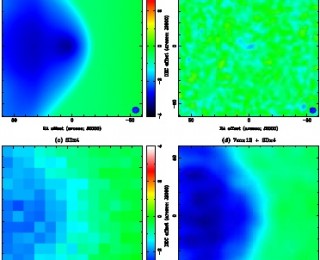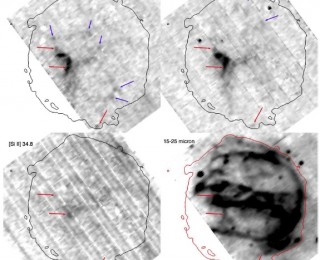
by Adele Plunkett | Apr 27, 2012 | Daily Paper Summaries
This paper suggests a new quantity to measure the brightness of gas emission throughout the Milky Way, and determines the regions where most stars are likely to be forming in our Galaxy.

by Adele Plunkett | Mar 30, 2012 | Daily Paper Summaries
In order to prepare for ALMA observations, these authors make mock-observations of simulated data, and they show that ALMA will be an ideal observatory for studying galaxy clusters using the SZ effect.
by Adele Plunkett | Mar 4, 2012 | Personal Experiences
Note: This is the second astrobite in a periodic series chronicling my adventures doing astronomy research in Chile (click here to read the first astrobite of the series). For details on ALMA (the Atacama Large Millimeter/submillimeter Array), check out the observatory’s website, and go here for resources with more details on ALMA science and techniques. An Introduction to Millimeter/Sub-millimeter InterferometryAn important feature of a telescope is its resolution, or the degree of detail that it can observe. The resolution depends on the ratio of wavelength of light to diameter of the telescope dish/mirror; in other words, observations will be higher resolution if they are of shorter wavelength light and/or made with a larger diameter telescope. ALMA is sensitive to light with wavelengths that are from about 300 micrometers to 3 millimeters (approximately 0.0003 to 0.003 meters). This is called millimeter and submillimeter radiation, and it falls at the short wavelength (high frequency) end of the radio spectrum. For comparison, visible light has wavelengths about 1000 times shorter, between roughly 380 and 750 nanometers (0.00000038 to 0.00000075 meters). This balance of wavelength and telescope diameter results in the interesting fact that a single 7- or 12-m ALMA antenna “sees” only slightly more detail than your eye can see in visible wavelengths.The science goals of ALMA require very high resolution. (A quick note: resolution is measured as an angle, and in this post I will use units of arcseconds. Remember, 1 degree equals 3600 arcseconds, and for reference, the apparent size of the moon is about 0.5 degrees, or 1800 arcseconds.) Given the wavelength constraints, the best way to achieve high...

by Adele Plunkett | Mar 2, 2012 | Daily Paper Summaries
Paper title: Spitzer Imaging and Spectral Mapping of the Oxygen-rich Supernova Remnant G292.0+1.8 Authors: P. Ghavamian, K. Long, W. Blair, S. Park, R. Fesen, B. Gaensler, J. Hughes, J. Rho, P. F. Winkler First Author’s Affiliation: Towson University, MarylandA star ends its life in a violent supernova (SN) explosion according to one of two (general) mechanisms — (1) core-collapse, forming a neutron star or black hole and an extremely energetic shock wave; or (2) thermonuclear explosion of a white dwarf, leaving no central remnant and releasing a very characteristic amount of energy used to infer the distance to these standard candles. Core-collapse SNe can be further classified according to their progenitor stars as type II, Ib or Ic, while thermonuclear supernovae are known as type Ia. More discussion on types of SNe can be found here, or in this Science in the News piece by another astrobiter.One way to better understand how SNe progress is by studying the leftovers, or remnants, of these events (if you like supernova remnants, check out this astrobite too). For example, G292.0+1.8 is a collection of cosmic remains from an unrecorded supernova event that probably occurred about 3000 years ago, and it is unique for its oxygen-dominated optical spectra — hence, its classification as an oxygen-rich supernova remnant (SNR). Moreover, G292 is the remnant of a core-collapse SN, with filaments of gas and dust emitting light as shocks from the SNR propagate outward into the circumstellar medium. The goal of today’s paper is to study emission from G292 at different wavelengths in order to investigate the energy and the morphology of core-collapse SNe.Observations of...

by Adele Plunkett | Feb 3, 2012 | Daily Paper Summaries
Title: Line profiles of cores within clusters: I. The anatomy of a filament Authors: Rowan J. Smith, Rahul Shetty, Amelia M. Stutz, Ralf S. Klessen First Author’s Institution: Centre for Astronomy at the University of Heidelberg, GermanyStars are a fundamental component of the universe, building blocks of larger structures like galaxies and galaxy clusters. The cycle of star formation, evolution, death and rebirth, recycling on cosmic scales, is interesting but difficult to observe at all stages. Within our lifetimes, we can’t observe one star as it progresses through a complete life-cycle, but we can observe a variety of stars at a variety of evolutionary stages in order to tell the whole story. However, it remains a challenge to observe stars in the earliest stages as they are forming. Stars form in dense environments obscured by cold dusty material. One tool for identifying star-forming cores (this is the terminology used when a cloud of molecular gas has collapsed and begins to form a star) is the observed blue infall asymmetry. Let me explain.When you (the observer) stare straight into a (spherical) core as it collapses, you will see some gas on the near side of the cloud moving away from you and some gas on the far side of the cloud moving towards you. Remember, you only see a 2-D picture, and using the doppler shifting of light, you will only measure the velocity component projected along the line of sight. Along any line of sight, there will be two elements of gas with similar line-of-sight velocity components. However, considering that the gas is dense enough and becomes opaque at...




